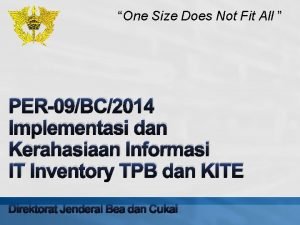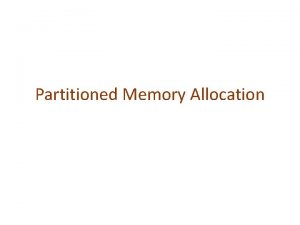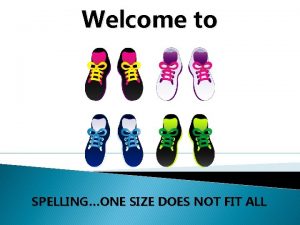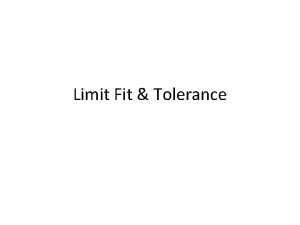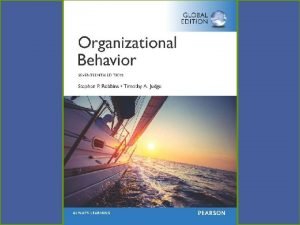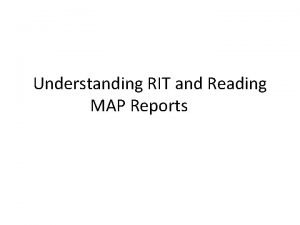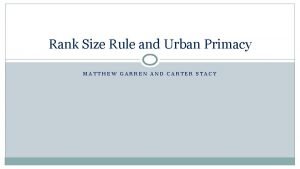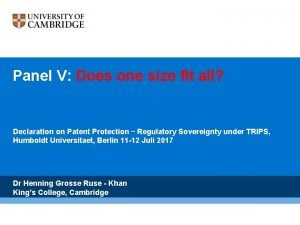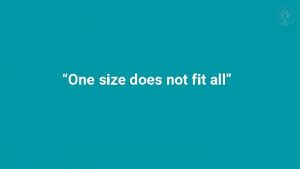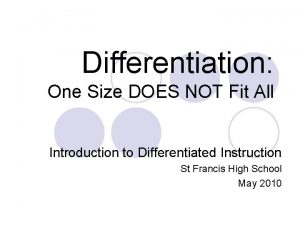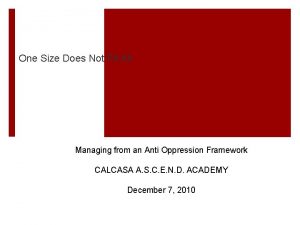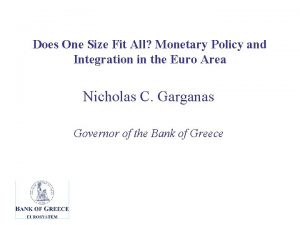Does One Size Fit All Determinants of Insurer






















- Slides: 22

Does One Size Fit All? Determinants of Insurer Capital Structure Around the Globe Muhammed Altuntas University of Cologne Thomas R. Berry-Stölzle University of Georgia Department of Risk Management & Insurance University of Cologne Sabine Wende University of Cologne Slide: 1

Agenda 1 Introduction 2 Theoretical Background 3 Data & Methodology 4 Results 5 Conclusion Department of Risk Management & Insurance Slide: 2

Introduction ► ► Since the International Association of Insurance Supervisors (IAIS) was established in 1994, insurance regulators and supervisors from over 140 countries have been working on promoting globally consistent supervision of the insurance industry. The Com. Frame working draft released on July 2, 2012 explicitly states that the IAIS decided, “Com. Frame shall develop a partially harmonized approach to group capital for solvency assessment purposes” (IAIS, 2012 b, p. 8). Goal of this research: examine insurers’ capital structure across a broad range of countries including those in developing markets (impact of country specific characteristics on insurer capital structure). We find that: 1. …the optimal capital structure of insurers is not homogeneous across countries 2. …country-level factors explain a substantial fraction of the cross-sectional variation in insurers’ capitalization levels Department of Risk Management & Insurance University of Cologne Slide: 3

Introduction (II) ► ► ► If insurer capital structure is not homogeneous across countries, imposing the same regulatory capital requirements on all insurance companies around the globe will not make sense. Cheng and Weiss (2012) focus on the U. S. property-liability insurance industry for the years 1994 -2002 and examine firm-level determinants of insurer capital structure. The contribution of our study: We examine both firm-level and country-level determinants of insurer capital structure: 1. Research design extends the literature by providing novel evidence on the impact of country characteristics on insurance companies’ capital structure choice 2. Research contributes to the literature by providing additional evidence on the effect of firm-level determinants on insurance companies’ capital structure across a broad range of economies including those in the developing markets Department of Risk Management & Insurance University of Cologne Slide: 4

Theoretical Background ► ► Doherty and Tinic (1982) extend the classic Modigliani-Miller irrelevance result and show that changing the level of capital inside an insurance company cannot create value in a world with perfect capital markets. In the presence of market imperfections, however, Froot (2008) shows that insurance companies arrive at an optimal capital structure that trades off the costs and benefits of holding capital. Cost of raising new capital, and hence the benefit of holding capital, is relatively high for opaque insurance companies which are hard to evaluate by outside investors. Similarly, the benefit of holding capital is relatively high for mutual insurance companies because mutual insurers cannot raise capital from equity markets; mutual insurers can only raise capital through the issuance of surplus notes, a form of highly subordinated debt. Department of Risk Management & Insurance University of Cologne Slide: 5

Theoretical Background (II) ► ► ► Overall we expect larger, more diversified insurers, and insurers operating in less volatile business lines to hold less capital, and mutual insurers and relatively opaque insurers to hold more capital. Coase (1937) and Williamson (1985) highlights that firms do not operate in a vacuum and suggests that a firm’s institutional environment impacts the firm’s optimal structure (transaction cost theory). We argue that: 1. Optimal capital structure of insurers is not homogenous across countries 2. Country characteristics influence firms’ costs and benefits of holding capital and, hence, their capital structure choice 3. Country-level factors that impact firms’ capital structure decisions are a country’s degree of capital market development, the level of property rights protection in the country, the transparency of a country’s accounting system, and the costs associated with financial distress Department of Risk Management & Insurance University of Cologne Slide: 6

Theoretical Background (III) ► We expect that: 1. Holding capital is less valuable in countries with well-developed capital markets where it is relatively easy to raise external capital 2. Holding capital is more valuable in countries with poorer property rights protection, including investor protection 3. Holding capital is more valuable in countries with less transparent accounting standards where the cost of raising capital is relatively high due to agency costs and information asymmetries 4. Holding capital is more valuable in countries with relatively high financial distress costs. Financial distress costs are especially high in countries where individuals are risk averse and willing to pay a substantial premium for policies of financially stable insurers. Department of Risk Management & Insurance University of Cologne Slide: 7

Data & Methodology Sample and Data: ► ► ► There are substantial differences in the products offered by property-liability insurance companies and life insurance companies and, hence, their capital structure. Two firm-level samples of property-liability and life insurance companies, respectively, from A. M. Best’s Statement File Global for the period 2001 through 2008. Initial data: all listed insurers for the period 1999 -2008, but database includes a large number of data fragments without even basic information on the companies. → Exclude data entries for which the company description is missing → Exclude companies classified as reinsurers or pure holding companies → Exclude companies that report negative direct premiums written, premiums earned, total assets, and policyholder surplus or investment positions Department of Risk Management & Insurance University of Cologne Slide: 8

Data & Methodology (II) ► ► ► Split the sample in two parts, separating the property-liability insurers from the life insurers. Exclude companies with missing data on the basic accounting variables used to calculate the firm-level variables used in the regression analysis. We use lagged values for some of our independent variables: → Exclude firm-year observations for which the preceding two years of data are not available ► ► Finally, we exclude extreme outliers from the two samples. Our first outlier screen is to eliminate firm-year observations with reported life (non-life) insurance premiums in excess of the overall premium volume of the corresponding country’s life (nonlife) insurance market. Next, we eliminate observations if the return on equity (ROE) has a value above one or below minus one (Berger and Ofek, 1995). Department of Risk Management & Insurance University of Cologne Slide: 9

Data & Methodology (III) ► A. M. Best’s Statement File Global has a home country bias and overrepresents U. S. insurers in the database. → We limit the number of unique U. S. insurance companies in our property-liability insurer sample to 40% (life to 29%), which corresponds to the average world market share of U. S. insurers across the 2001 -2008 period → We randomly select insurance companies from the universe of all U. S. insurers until the total number of U. S. insurers accounts for 40% (29%) of insurance companies in our sample, and we remove all other U. S. insurers ► ► Data for countries’ life and non-life insurance market premium volume are obtained from Swiss Re’s Sigma publications. Final Sample over the period 2001 -2008: → P&L: 6, 545 insurer-year observations from 28 different countries → Life: 2, 001 insurer-year observations from 14 countries Department of Risk Management & Insurance University of Cologne Slide: 10

Data & Methodology (IV) Variance Decomposition Analysis of Firm-Level Determinants and Country Fixed Effects ► We conduct a variance decomposition analysis to assess the importance of firmlevel determinants of insurer capital structure relative to time-invariant country-level factors (country fixed effects), see Lemmon et al. (2008): Leveragei, c, t = α + β 1 Xi, c, t-1 + β 2 Dc + β 3 Dt + ε ► (1) Firm specific factors are: Reinsurance Stdev. of lossratio Longtail business Product mix Premium growth Size Mutual Group Ratio of reinsurance ceded to reinsurance premiums assumed plus direct premiums. Standard deviation of the net claims incurred divided by premiums earned (2000 -2008). Ratio of total gross provisions to sum of gross premiums. Risk versus saving products. Growth in net earned premiums. Natural logarithm of the insurer’s total assets. Dummy variable equal to one if the insurer is a mutual, and zero otherwise. Dummy variable equal to one if the insurer is a member of a group, and zero otherwise. Department of Risk Management & Insurance University of Cologne Slide: 11

Data & Methodology (V) Quantifying the Impact of Specific Country-Level Factors on Capital Structure ► ► Here, we focus on specific country characteristics rather than country fixed effects. To examine the explanatory power of these country-level factors for firms’ leverage levels, we include these country-level factors in a reduced form model of insurer leverage and perform a variance decomposition analysis. The business environment in a country may not just have a level effect on the capital structure of all insurers operating in that country, but may also moderate the relationship between firm-level factors and capital structure. To capture any indirect effects of country characteristics on firms’ capital structure, we include interaction terms between all firm-level variables and the country-level factors into the model. The specification of the model is as follows: Leveragei, c, t = α + β 1 Xi, c, t-1 + β 2 Cc, t-1 + β 3 X*C + ε Department of Risk Management & Insurance University of Cologne (2) Slide: 12

Data & Methodology (VI) ► ► ► Ease of access to capital markets: We use the Credit to Private Sector variable, the Country Credit Rating variable and a number of indices measuring Shareholder and Creditor Rights to proxy for the accessibility of capital markets in a country. In addition, we use a number of indices measuring Equity Disclosure Requirements to proxy for the degree of asymmetric information in a country. Cost of financial distress: We use measures of Uncertainty Avoidance and Long. Term Orientation in a country’s population and a Savings variable as proxies for financial distress costs in a country. Property rights protection: We use the Political Risk Index variable, the Strength of Legal System Index variable and a number of indices measuring Government Quality to proxy for the level of property rights protection in a country. Competition: We use the Market Concentration and the Insurance Penetration variables to proxy for the level of competition in a country. Macroeconomic determinants: We use the Inflation rate and the GDP growth to proxy for the macroeconomic conditions in a country. Department of Risk Management & Insurance University of Cologne Slide: 13

Data & Methodology (VII) A Partial Adjustment Model of Leverage ► Here, we estimate a partial adjustment model of insurer leverage with country-firm interaction terms: Leveragei, c, t = α + Leverage i, c, t-1 + β 1 Xi, c, t-1 + β 2 Cc, t-1 + β 3 X*C + ε ► (3) Following Gungoraydinoglu and Öztekin’s (2011) analysis of leverage of nonfinancial firms, we estimate Equation (3) with Blundell and Bond’s (1998) generalized method of moments (GMM) estimator. Among the recently proposed alternative dynamic panel data estimators, Blundell and Bond’s (1998) system GMM estimator is expected to have the least bias for the model in Equation (3) (Flannery and Hankins, 2012). Department of Risk Management & Insurance University of Cologne Slide: 14

Univariate Comparison between Insurers with High and Low Leverage Panel A: Property-Liability Insurance Companies Firm characteristics Reinsurance Std. dev. of loss ratio Longtail business Premium growth Size Mutual Group Full sample N Mean Median Std. Dev. 6, 545 0. 340 0. 263 0. 749 6, 947 1. 287 0. 091 23. 635 6, 928 5. 227 1. 099 141. 324 6, 947 0. 260 0. 114 3. 257 6, 947 12. 299 12. 272 1. 876 6, 947 0. 181 0. 000 0. 385 6, 947 0. 701 1. 000 0. 458 Firms with leverage below sample median N Mean Median 3, 270 0. 370 0. 292 3, 474 1. 699 0. 105 3, 460 8. 099 0. 823 3, 474 0. 220 0. 096 3, 474 11. 610 11. 564 3, 474 0. 248 0. 000 3, 474 0. 654 1. 000 N 3, 275 3, 473 3, 468 3, 473 Firms with leverage above sample median Median 0. 311 *** 0. 242 *** 0. 876 0. 079 *** 2. 362 * 1. 368 *** 0. 300 0. 137 *** 12. 990 *** 12. 985 *** 0. 114 *** 0. 000 *** 0. 747 *** 1. 000 *** N 905 1, 000 1, 000 Firms with leverage above sample median Median 0. 099 *** 0. 027 *** 0. 117 *** 0. 092 *** 0. 619 0. 087 15. 568 *** 15. 626 *** 0. 174 *** 0. 000 *** 0. 802 *** 1. 000 *** Panel B: Life-Health Insurance Companies Firm characteristics Reinsurance Product mix Premium growth Size Mutual Group Full sample N Mean Median Std. Dev. 1, 837 0. 143 0. 048 0. 212 1, 997 0. 337 0. 108 1. 668 2, 001 0. 441 0. 080 8. 997 2, 001 14. 351 14. 542 2. 361 2, 001 0. 135 0. 000 0. 342 2, 001 0. 730 1. 000 0. 444 Department of Risk Management & Insurance Firms with leverage below sample median N Mean Median 932 0. 187 0. 078 997 0. 558 0. 140 1, 001 0. 264 0. 074 1, 001 13. 135 12. 908 1, 001 0. 097 0. 000 1, 001 0. 658 1. 000 University of Cologne Slide: 15

Explanatory Power of Firm-Level Determinants, Country Fixed Effects, and Year Fixed Effects (P&L) Model (1) Variance OLS Decomp. Coefficients Firm-specific factors Reinsurance 1. 87 0. 42456 *** Std. dev. of loss ratio 0. 01 -0. 00048 Longtail business 0. 07 -0. 00021 Premium growth 0. 02 -0. 00011 Size 73. 40 0. 50078 *** Mutual 16. 00 -1. 10768 *** Group 8. 62 -0. 70926 *** Year and country fixed effects Country FE Year FE Summary Firm effect 100. 00 Country effect Year effect Adj. R-squared 0. 12 Number of 6, 947 observations Number of countries 28 Department of Risk Management & Insurance Model (5) Variance OLS Decomp. Coefficients 1. 72 0. 44503 *** 0. 05 -0. 00103 0. 04 -0. 00017 0. 02 -0. 00011 67. 48 0. 53472 *** 13. 07 -1. 09534 *** 7. 84 -0. 74048 *** Model (7) Variance OLS Decomp. Coefficients 3. 51 0. 82109 *** 0. 04 -0. 00126 0. 01 -0. 00009 0. 03 -0. 00018 18. 95 0. 38630 *** 3. 57 -0. 74994 *** 0. 45 -0. 25300 *** 9. 79 90. 21 9. 79 0. 14 6, 947 28 69. 19 4. 24 26. 57 69. 19 4. 24 University of Cologne 0. 31 6, 947 28 Slide: 16

Explanatory Power of Firm-Level Determinants, Country Fixed Effects, and Year Fixed Effects (Life) Model (1) Variance OLS Decomp. Coefficients Firm-specific factors Reinsurance 1. 35 -5. 79453 ** Product mix 1. 36 -0. 81972 ** Premium growth 0. 21 -0. 02770 Size 80. 91 4. 15336 *** Mutual 1. 55 3. 79076 ** Group 14. 61 8. 87953 *** Year and country fixed effects Country FE Year FE Summary Firm effect 100. 00 Country effect Year effect Adj. R-squared 0. 21 Number of 2, 001 observations Number of countries 14 Department of Risk Management & Insurance Model (5) Variance OLS Decomp. Coefficients 1. 24 -5. 68775 ** 1. 27 -0. 80828 ** 0. 25 -0. 03106 78. 96 4. 20148 *** 1. 33 3. 58195 ** 14. 55 9. 05716 *** Model (7) Variance OLS Decomp. Coefficients 0. 45 6. 37128 *** 0. 00 -0. 01919 0. 07 -0. 02806 20. 96 4. 17014 *** 0. 28 -3. 00032 ** 0. 35 2. 54677 *** 2. 40 97. 60 2. 40 0. 21 2, 001 14 76. 39 1. 50 22. 11 76. 39 1. 50 University of Cologne 0. 57 2, 001 14 Slide: 17

Explanatory Power of Firm and Country-Level Determinants Property-Liability Industry Firm-specific factors Reinsurance Std. dev. of loss ratio Longtail business Premium growth Size Mutual Group Institutional factors Direct institutional effect (I) Reinsurance*(I) Std. dev. of loss ratio*(I) Longtail business*(I) Premium change*(I) Size*(I) Mutual*(I) Group*(I) Summary Firm effect Direct institutional effect Indirect institutional effect Adj. R-squared Number of observations Number of countries Average 5. 73 4. 45 0. 30 0. 07 29. 56 6. 82 11. 48 3. 92 6. 94 4. 56 0. 30 0. 08 7. 18 4. 59 14. 02 58. 42 3. 92 37. 66 0. 17 6, 920 27 Department of Risk Management & Insurance Life Industry Firm-specific factors Reinsurance Product mix Premium growth Size Mutual Group Institutional factors Direct institutional effect (I) Reinsurance*(I) Product mix*(I) Premium change*(I) Size*(I) Mutual*(I) Group*(I) Summary Firm effect Direct institutional effect Indirect institutional effect Adj. R-squared Number of observations Number of countries University of Cologne Average 1. 59 2. 56 0. 12 27. 47 9. 65 12. 95 8. 44 1. 75 2. 70 0. 11 11. 50 10. 36 10. 82 54. 33 8. 44 37. 23 0. 32 1, 989 14 Slide: 18

Impact of Firm- and Country-Level Determinants on the CS Property-Liability Industry Leverage Reinsurance Std. dev. of loss ratio Longtail business Premium growth Size Mutual Group Inflation GDP growth Institution (I) Reinsurance*(I) Std. dev. of loss ratio*(I) Longtail business*(I) Premium change*(I) Size*(I) Mutual*(I) Group*(I) Inflation*(I) GDP growth*(I) Country FE Year FE AR(1)/AR(2) Sargan Observations Countries Market capitalization 0. 67453*** 0. 29015 -0. 01111*** -0. 00245** 0. 05615 -0. 12960*** -0. 30602** -0. 27780* -0. 01974*** 0. 36541 -0. 02093*** -0. 00167 0. 00003** 0. 00002** 0. 00036 0. 00147*** 0. 00065 0. 00122 -0. 00033** 0. 05099** Yes 0. 00/0. 66 0. 15 5, 279 27 Financial efficiency 0. 67684*** 0. 16035 0. 02896 -0. 00081 0. 06128 -0. 06661 0. 27666 -0. 43426 -0. 02588** 11. 55314*** -5. 70218 -0. 06820 -0. 01767 0. 00030 -0. 02505 0. 10752*** -0. 30117 0. 25394 0. 00416 -4. 08814*** Yes 0. 00/0. 60 0. 64 5, 199 24 Department of Risk Management & Insurance Life-Industry Leverage Reinsurance Product mix Premium growth Size Mutual Group Inflation GDP growth Institution (I) Reinsurance*(I) Product mix*(I) Premium change*(I) Size*(I) Mutual*(I) Group*(I) Inflation*(I) GDP growth*(I) Country FE Year FE AR(1)/AR(2) Sargan Observations Countries University of Cologne Market capitalization 0. 85871*** 11. 93258*** 0. 94777*** 0. 83077*** 0. 81073*** -0. 07830 -2. 16598*** -0. 11085 -6. 16280 0. 00342 -0. 09155*** -0. 00845*** -0. 00142 -0. 00281*** -0. 02822*** 0. 01969*** 0. 00654*** 0. 26215*** Yes 0. 00/0. 73 0. 45 1, 509 14 Financial efficiency 0. 85458*** -3. 96689** 0. 60888 -1. 57405*** -0. 61915*** -18. 14966*** 1. 10680 0. 61948*** 44. 96211*** 0. 00863 5. 95024*** -0. 38246 0. 94596*** 0. 29796*** 5. 95761*** 0. 65467*** -0. 23128*** -28. 41800*** Yes 0. 00/0. 90 0. 40 1, 489 13 Slide: 19

Conclusion ► ► ► Previous research has ignored country-level determinants of insurer capital structure. This research examines the determinants of insurance companies’ capital structure across a broad range of economies including both, developed and emerging market countries. We find that country characteristics matter and that country-level factors explain a substantial fraction of the variation in insurance companies’ capital structure. This research has an important public policy implication. If insurer capital structure is not homogeneous across countries, imposing the same regulatory capital requirements on all insurance companies around would lead to substantial market distortion. Regulators should rather work on improving cooperation and information sharing with respect to supervision of multinational insurance companies and on procedures to quickly resolve multinational insurance companies then on harmonizing capital standards across heterogeneous markets. Department of Risk Management & Insurance University of Cologne Slide: 20

Back-up: Description of Firm- and Country-Level Determinants Variable name Variable description, and source Firm-level determinants Leverage Book leverage; ratio of total assets minus capital surplus to capital surplus. Source: A. M. Best’s Statement File Global. Reinsurance Ratio of reinsurance ceded to reinsurance premiums assumed plus direct premiums. Source: A. M. Best’s Statement File Global. Std. dev. of loss ratio Standard deviation of the net claims incurred divided by premiums earned for the years 2000 -2008. Source: A. M. Best’s Statement File Global. Longtail business Ratio of total gross provisions to sum of gross premiums. Source: A. M. Best’s Statement File Global. Product mix Risk versus saving products. Source: A. M. Best’s Statement File Global. Premium growth Growth in net earned premiums. Source: A. M. Best’s Statement File Global. Size Natural logarithm of the insurer’s total assets. Source: A. M. Best’s Statement File Global. Mutual Dummy variable equal to one if the insurer is a mutual, and zero otherwise. Source: A. M. Best’s Statement File Global. Group Dummy variable equal to one if the insurer is a member of a group, and zero otherwise. Source: A. M. Best’s Statement File Global. Country-level determinants Access to financial markets Market capitalization of listed companies (% of GDP). Source: World Development Indicators. Financial efficiency Financial system’s efficiency. Measured by the logarithm of the total value-traded ratio divided by overhead costs. The total value-traded ratio captures the efficiency of stock markets and the overhead costs capture the efficiency of the banking sector. Source: Levine (2002). Credit to private sector Amount of credit banks provide to private sector as a percent of GDP. Source: World Development Indicators. Country credit rating Average of two ratings published semi-annually. The ratings are based on surveys of bankers and are on a scale from 0 to 100, with higher values indicating a better rating. Source: Institutional Investor. Shareholder rights Anti-director rights index ranges from 0 (weak shareholder rights) to 5 (strong shareholder rights). Source: La Porta et al. (1998). Creditor rights index ranges from 0 (weak creditor rights) to 4 (strong creditor rights). Source: La Porta et al. (1998). Corporate transparency The index is created by examining and rating companies’ 1990 annual reports on their inclusion or omission of 90 items. These items fall into seven categories (general information, income statements, balance sheets, funds flow statement, accounting standards, stock data, and special items). Source: La Porta et al. (1998). Equity disclosure The index equals the arithmetic mean of prospectus, compensation, shareholders, inside ownership, and transactions. Source: La Porta et al. (2006). Equity liability The index equals the arithmetic mean of (1) liability standard for the issuer and its directors, (2) liability standard for distributors, and (3) liability standard for accountants. Higher scores indicate stronger liability standards. Source: La Porta et al. (2006). Department of Risk Management & Insurance University of Cologne Slide: 21

Back-up: Description of Firm- and Country-Level Determinants (II) Variable name Variable description, and source Country-level determinants Cost of financial distress Uncertainty avoidance Measures the extent to which people feel uncomfortable with uncertainty and ambiguity. Source: Hofstede et al. (2010) and Hofstede’s Homepage. Long-term orientation Reflects long-term pragmatic attitudes versus short-term normative attitudes. Cultures scoring high on this dimension show emphasis on future rewards, in particular saving, persistence and adapting to changing circumstances. Source: Hofstede et al. (2010) and Hofstede’s Homepage. Savings Gross savings in percent of GDP. Gross savings are calculated as gross national income less total consumption, plus net transfers. Source: World Development Indicators. Property rights protection Government Reflects perceptions of the quality of public services, the quality of the civil service and the degree of its independence from political pressures, effectiveness the quality of policy formulation and implementation, and the credibility of the government's commitment to such policies. This index ranges from approximately -2. 5 (weak) to 2. 5 (strong) governance performance. Source: World Development Indicators. Political risk index Index is an assessment of government accountability and stability, quality of bureaucracy and law enforcement, investment climate, and various sources of political and social conflicts. The index takes on values between zero and 100, with lower values representing unstable institutions and higher risk. Source: PRS International Country Risk Guide Researchers dataset. Strength of legal rights index measures the degree to which collateral and bankruptcy laws protect the rights of borrowers and lenders and thus System facilitate lending. The index ranges from 0 to 10, with higher scores indicating that these laws are better designed to expand access to credit. Source: World Development Indicators. Time to enforce a Procedures to enforce a contract are the number of independent actions, mandated by law or courts that demand interaction between the parties contract of a contract or between them and the judge or court officer. Source: World Development Indicators. Competition Market concentration Market share of the 5 largest insurers. It is calculated as the sum of premiums earned for the 5 largest insurers in the sample divided by the industry’s premiums written. Source: A. M. Best’s Statement File Global, and Swiss Re Sigma publications. Insurance penetration is the ratio of the industry’s premiums written to GDP. Source: World Development Indicators, and Swiss Re Sigma publications. Macroeconomic determinants Inflation rate Annual inflation rate. Growth in Consumer Price Index (CPI). Source: World Development Indicators. GDP growth Economic growth. Growth in nominal Gross Domestic Product (GDP). Source: World Development Indicators. Department of Risk Management & Insurance University of Cologne Slide: 22
 Next fit memory allocation
Next fit memory allocation Elt supervision
Elt supervision One size does not fit all
One size does not fit all One size does not fit all in education
One size does not fit all in education Memory allocation policy
Memory allocation policy For one size does not all
For one size does not all Maximum and minimum metal condition
Maximum and minimum metal condition Person-job fit and person-organization fit
Person-job fit and person-organization fit Rit uid
Rit uid Rank-size rule
Rank-size rule Name all the lines
Name all the lines One god one empire one religion
One god one empire one religion One one one little dog run
One one one little dog run One king one law one faith
One king one law one faith Byzantine definition
Byzantine definition Ford one plan
Ford one plan See one do one teach one
See one do one teach one See one, do one, teach one
See one, do one, teach one Structure of twelfth night
Structure of twelfth night See one do one teach one
See one do one teach one One vision one identity one community
One vision one identity one community Graphic organizer with the aims of la liga filipina
Graphic organizer with the aims of la liga filipina Const table
Const table


